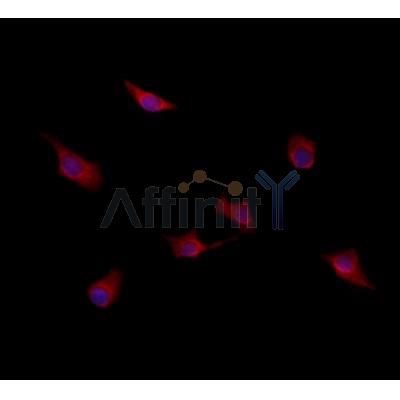ANO1 Antibody - #DF7769
| Product: | ANO1 Antibody |
| Catalog: | DF7769 |
| Description: | Rabbit polyclonal antibody to ANO1 |
| Application: | WB IHC IF/ICC |
| Reactivity: | Human, Mouse, Rat |
| Prediction: | Horse, Dog |
| Mol.Wt.: | 90 kDa; 114kD(Calculated). |
| Uniprot: | Q5XXA6 |
| RRID: | AB_2841235 |
Related Downloads
Protocols
Product Info
*The optimal dilutions should be determined by the end user. For optimal experimental results, antibody reuse is not recommended.
*Tips:
WB: For western blot detection of denatured protein samples. IHC: For immunohistochemical detection of paraffin sections (IHC-p) or frozen sections (IHC-f) of tissue samples. IF/ICC: For immunofluorescence detection of cell samples. ELISA(peptide): For ELISA detection of antigenic peptide.
Cite Format: Affinity Biosciences Cat# DF7769, RRID:AB_2841235.
Fold/Unfold
ANO 1; ANO1; ANO1_HUMAN; Anoctamin 1; Anoctamin 1 calcium activated chloride channel; Anoctamin-1; Anoctamin1; Ca2+ activated Cl- channel; Calcium Activated Chloride Channel; Discovered on gastrointestinal stromal tumors protein 1; DOG 1; DOG1; FLJ10261; Membrane protein; Oral cancer overexpressed 2; Oral cancer overexpressed protein 2; ORAOV 2; ORAOV2; TAOS 2; TAOS2; TMEM 16A; TMEM16A; Transmembrane protein 16A (eight membrane spanning domains); Transmembrane protein 16A; Tumor amplified and overexpressed sequence 2; Tumor-amplified and overexpressed sequence 2;
Immunogens
A synthesized peptide derived from human ANO1, corresponding to a region within the internal amino acids.
Broadly expressed with higher levels in liver, skeletal muscle and gastrointestinal muscles.
- Q5XXA6 ANO1_HUMAN:
- Protein BLAST With
- NCBI/
- ExPASy/
- Uniprot
MRVNEKYSTLPAEDRSVHIINICAIEDIGYLPSEGTLLNSLSVDPDAECKYGLYFRDGRRKVDYILVYHHKRPSGNRTLVRRVQHSDTPSGARSVKQDHPLPGKGASLDAGSGEPPMDYHEDDKRFRREEYEGNLLEAGLELERDEDTKIHGVGFVKIHAPWNVLCREAEFLKLKMPTKKMYHINETRGLLKKINSVLQKITDPIQPKVAEHRPQTMKRLSYPFSREKQHLFDLSDKDSFFDSKTRSTIVYEILKRTTCTKAKYSMGITSLLANGVYAAAYPLHDGDYNGENVEFNDRKLLYEEWARYGVFYKYQPIDLVRKYFGEKIGLYFAWLGVYTQMLIPASIVGIIVFLYGCATMDENIPSMEMCDQRHNITMCPLCDKTCSYWKMSSACATARASHLFDNPATVFFSVFMALWAATFMEHWKRKQMRLNYRWDLTGFEEEEEAVKDHPRAEYEARVLEKSLKKESRNKEKRRHIPEESTNKWKQRVKTAMAGVKLTDKVKLTWRDRFPAYLTNLVSIIFMIAVTFAIVLGVIIYRISMAAALAMNSSPSVRSNIRVTVTATAVIINLVVIILLDEVYGCIARWLTKIEVPKTEKSFEERLIFKAFLLKFVNSYTPIFYVAFFKGRFVGRPGDYVYIFRSFRMEECAPGGCLMELCIQLSIIMLGKQLIQNNLFEIGIPKMKKLIRYLKLKQQSPPDHEECVKRKQRYEVDYNLEPFAGLTPEYMEMIIQFGFVTLFVASFPLAPLFALLNNIIEIRLDAKKFVTELRRPVAVRAKDIGIWYNILRGIGKLAVIINAFVISFTSDFIPRLVYLYMYSKNGTMHGFVNHTLSSFNVSDFQNGTAPNDPLDLGYEVQICRYKDYREPPWSENKYDISKDFWAVLAARLAFVIVFQNLVMFMSDFVDWVIPDIPKDISQQIHKEKVLMVELFMREEQDKQQLLETWMEKERQKDEPPCNHHNTKACPDSLGSPAPSHAYHGGVL
Predictions
Score>80(red) has high confidence and is suggested to be used for WB detection. *The prediction model is mainly based on the alignment of immunogen sequences, the results are for reference only, not as the basis of quality assurance.
High(score>80) Medium(80>score>50) Low(score<50) No confidence
Research Backgrounds
Calcium-activated chloride channel (CaCC) which plays a role in transepithelial anion transport and smooth muscle contraction. Required for the normal functioning of the interstitial cells of Cajal (ICCs) which generate electrical pacemaker activity in gastrointestinal smooth muscles. Acts as a major contributor to basal and stimulated chloride conductance in airway epithelial cells and plays an important role in tracheal cartilage development.
Cell membrane>Multi-pass membrane protein. Cytoplasm.
Note: Cytoplasmic localization seen in neoplastic cells of head and neck squamous cell carcinoma (HNSCC) tumors.
Broadly expressed with higher levels in liver, skeletal muscle and gastrointestinal muscles.
The region spanning the fifth and sixth transmembrane domains probably forms the pore-forming region.
Belongs to the anoctamin family.
References
Restrictive clause
Affinity Biosciences tests all products strictly. Citations are provided as a resource for additional applications that have not been validated by Affinity Biosciences. Please choose the appropriate format for each application and consult Materials and Methods sections for additional details about the use of any product in these publications.
For Research Use Only.
Not for use in diagnostic or therapeutic procedures. Not for resale. Not for distribution without written consent. Affinity Biosciences will not be held responsible for patent infringement or other violations that may occur with the use of our products. Affinity Biosciences, Affinity Biosciences Logo and all other trademarks are the property of Affinity Biosciences LTD.


